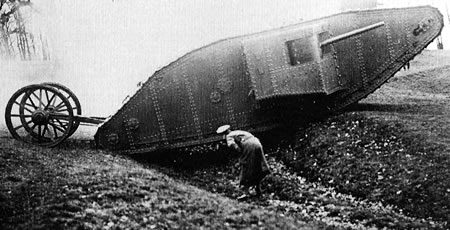During the building phase of ‘Little Willie’, Tritton and Wilson were working on its successor, which would be able to meet the War Office’s new requirements of traversing a trench 8 feet 6 inches (2.6 meters) across and climb over obstacles up to 4 and a half feet (1.37 meters) high.
The new machine was called ‘Big Willie’ and was, in fact, quite a lot different to its predecessor – it was the archetypal First World War tank, with tracks that went all the way around its curved body on either side. The only real similarity to the first model was the trailing wheels at the back to assist steering.
This tank had no space for a turret up top so, instead, it had a six-pounder mounted in half turrets, called sponsons, on either side of the vehicle.
Big Willie was also made from steam engine boiler plating, riveted to a frame of angle iron. It had the same engine as Little Willie but was more than twice as heavy, 28 tons, which would have put a lot of strain on the old gearbox setup so secondary gears were added to relieve the pressure and help with the steering.
 Big Willie had a crew of eight men, two of which operated the gears at the back to steer the tank. The tank commander operated the brakes, which also steered the tank in an emergency.
Big Willie had a crew of eight men, two of which operated the gears at the back to steer the tank. The tank commander operated the brakes, which also steered the tank in an emergency.
The tank was finished and ready for use in January 1916, her trials being undertaken only one month after Little Willie’s. She was discovered to be underpowered, with a top speed of only 3 miles per hour (5 km/h), but was more than capable of crossing a 9 foot trench. It was like a slow, crawling unstoppable juggernaut compared to anything seen before. The British government and war authorities were so impressed with this mighty machine that the Ministry of Munitions ordered 100 of them the following month, and by June the order had increased to 150.
The project was called Tank Mark One because, it is widely believed, the War Office and Landship Committee wanted to disguise its intended use during development, pretending that it is a water- tank. Big Willie did indeed have many different names, but to recognize its role as the parent of all tanks it became better known as ‘Mother’.
Twenty Five Mark I tanks were manufactured by Fosters, the rest of the numbers being made by the Metropolitan Carriage, Wagon and Finance Company of Oldbury in Birmingham. The tanks were given genders, male and female, in roughly 50/50 proportions. The male tanks were practically identical to ‘Mother’ and were given six-pounder guns and Hotchkiss machineguns, and the female tanks had modified sponsons with heavy Vickers machineguns fitted instead of six-pounders. A new army unit was created from the Heavy Section of the Machine Gun Corps to work with tanks, which began its training at Thetford, Bisley and Portsmouth.